




As we have reported on academic performance across schools in twelve Independent School Districts and thirteen charter networks operating in Fort Worth, one claim comes up year after year: that school performance is simply a function of poverty
Certainly, the percentage of economically disadvantaged students a school serves has historically been strongly correlated with student proficiency, a pattern often referred to as the Achievement Gap or, more recently, the Opportunity Gap However, it’s equally true that even among schools serving similar student populations, we see a wide variation in outcomes, including right here in Fort Worth
For example, currently in Fort Worth there are two schools with the same grade levels served, each with fewer than 10% economically disadvantaged students, that differ by nearly 30 percentage points in the number of students meeting grade-level math standards. Likewise, among two Fort Worth schools where more than 90% of students are economically disadvantaged, there is again a gap of more than 40 percentage points. If school performance were solely a function of economic status, how do we explain these differences between schools with such similar demographics?


One way we assess school performance is through a model called the Similar Schools Model, a model used by many organizations nationwide The model uses performance data from every public school in the state of Texas It examines the percentage of students meeting grade-level standards across the state and incorporates a range of demographic factors for each school, including school size, grade levels served, and the percentage of students who are economically disadvantaged, emergent bilingual, or receiving special education services, among others.
We can then apply that model to any individual school, and based on its specific demographic characteristics, the model estimates the percentage of students likely to meet grade-level standards, based on how schools with similar student populations perform across the state of Texas The visual above shows how every elementary and middle school in the City of Fort Worth performs compared to that estimate, indicating whether they outperform, meet, or fall below it
The schools we highlight in this report all fall into the 'Outperform' or 'Strongly Outperform' categories
These are the bright spot schools that give us hope - proof that all students can achieve at high levels and that it is happening right here in Fort Worth We spent time on each of these campuses to learn more about the practices driving their success We are deeply grateful for their willingness and generosity to share their stories with the broader Fort Worth community, and we hope you find their work as inspiring as we do

These are the bright spot schools that give us hope - proof that all students can achieve at high levels and that it is happening right here in Fort Worth.


City Council District: 9
District: Fort Worth ISD
Principal: Amelia Cortés-Rangel
Grades Served: Pre-K–5th
Enrollment: 441
Alice Contreras Elementary School achieved strong academic results in 2025, with 55% of students meeting grade-level standards in Reading and 51% in Math. These results place Contreras among the highest-performing campuses in Fort Worth among schools serving predominantly economically disadvantaged students, and even outperforming several schools that serve much more affluent student populations Over the past decade, Contreras has seen growth of more than 30 points in the percentage of students meeting grade level standards in Reading and more than 20 points in Math
Percentage of Students Meeting Grade Level in Reading, Spring 2025, by Campus in Fort Worth

Economically Disadvantaged Student Population: 92%
Special Education Student Population: 19%
Emergent Bilingual Student Population: 54%
Type of School: Traditional Public
Percentage of Students Meeting Grade Level in Math, Spring 2025, by Campus in Fort Worth


Principal Amelia Cortés-Rangel leads Alice Contreras Elementary with a deep personal sense of mission She began her leadership journey as an assistant principal at her childhood elementary school before stepping into the principal role at Contreras, where she has now served for eight years She carries with her a belief that defines her leadership: every child can learn, and it is up to us to create the systems that make that possible Her leadership is defined by uncompromising expectations paired with deep support Cortés-Rangel is often heard repeating the motto that perfectly encapsulates her leadership: “Why not us?” Whenever she and her team see success on another campus, they don’t begin from a place of barriers or reasons it won’t work at Contreras They start from a place of possibility: “Why not this campus? Why can’t it be us?” That mindset shapes everything about how the team at Contreras approaches their work, always assuming excellence is within reach and then building the systems to get there.
Driving up to Contreras, one might thin inside, they would find a school wrappe moment you enter the front doors, from Clark Academy) to the bulletin board fe sponsorships, it’s clear that at the heart families, and staff The campus is truly a fueled by resources that Principal Ameli Clear Non-Negotiables and Exp
Don’t let that joy fool you, though At C and they take that work seriously, with e between and among the leadership tea tool to revisit as needed. Early in her ten being on staff was to believe in and w of her early staff meetings where she pu her team: “Which child are we prepared expectation was clear: every child matte However, those high expectations come that the high levels of rigor are balanced massage chairs, workout equipment, an the campus places on ensuring that staf
At Contreras, teacher development and campus leadership reviews strengths an observation and coaching calendar for t trust between leaders and teachers Pro thoughtfully paired to observe exempla with a specific context in mind Before e focus on, then debrief together. This en
For Contreras, the campus improvemen success. It sets annual priorities and gui rooted in data, continues at every level and STAAR performance, with progress script student conferences so children c of intentionality keeps high-quality Tier student interventions layered in

Alice Contreras is defined by its balance of rigor and care. The motto ‘Why Not This Campus?’ ensures that the school continually reaches higher By embracing a growth mindset in pursuit of excellence, investing in teacher leadership, and keeping data personal, Contreras proves what’s possible when belief and discipline drive the work

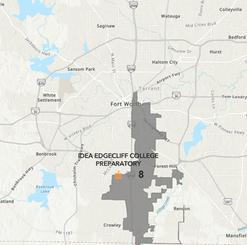
F A S T F A C T S
City Council District: 8
District: IDEA Public Schools
Principal: Kenieka Francis
Grades Served: 6th–11th
Enrollment: 604
IDEA Edgecliff College Prep stands out for its strong academic performance, with 61% of students meeting grade level in Reading and 48% in Math across grades 6–8 in 2025 As a school serving middle grades, a level where proficiency rates tend to lag significantly both statewide and in the City of Fort Worth, Edgecliff’s results are especially noteworthy Its performance places the campus among the highestperforming secondary schools serving predominantly economically disadvantaged students in Fort Worth, with the largest gap of any open-enrollment school between what the Similar Schools Model would project for its student population and its actual results.
Percentage of Students Meeting Grade Level in Reading, Spring 2025, by Middle School Campus in Fort Worth

Economically Disadvantaged Student Population: 79%
Special Education Student Population: 14%
Emergent Bilingual Student Population: 37%
Type of School: Public Charter
Percentage of Students Meeting Grad Level in Math, Spring 2025, by Middl School Campus in Fort Worth


Since IDEA Edgecliff College Prep opened its doors in 2020 under the leadership of Principal Kenieka Francis, the school has consistently outperformed the student achievement levels of other similar schools and received the highest marks in the state accountability system That level of consistency is a direct result of the Edgecliff staff’s intentionality, precision, and commitment to excellence in serving all students, which could be felt from the moment you walk through the campus doors From leadership huddles with a clear purpose, to carefully designed instructional coaching, building capacity drives success at IDEA Edgecliff, where every minute of the day, every team member throughout the school is fervently working to strengthen instruction and operations to meet every student’s needs and reach the high-level expectations they all hold themselves to, to ensure every child in the building reaching their core value of ‘achieving academic excellence’
At IDEA Edgecliff College Prep, campus culture is rooted in a clear set of core values that guide how every team member approaches their work: Act with Integrity, Achieve Academic Excellence, Deliver Results, Ensure Equity, Build Team and Family, Bring Joy, and Sweat the Small Stuff These values are not just posted on walls; they are lived out daily across the campus You can see them in the relentless pursuit of academic goals, with every class striving for 90% of students to approach grade level, 60% to meet grade-level standards, and 30% to master them on each assessment You see the core values in the counselor who doesn’t hesitate to get in the car for a home visit when a student has been absent for a few days, and you see them in the collective sense of urgency, care, and pride that defines how the Edgecliff team supports every student’s success
“Sweating the Small Stuff” may be one of IDEA Edgecliff College Prep’s core values, but the way this campus lives it out deserves to be highlighted on its own When we arrived at 8:30 a m , the front hallway was already alive with purpose A small group of campus leaders had gathered at rolling desks for their morning check-in, each sharing updates from the previous day’s priorities, outlining key focuses for the day ahead, and flagging any student concerns that required the team’s attention Principal Francis guided the conversation with a balance of gentleness and precision, offering context, asking clarifying questions, and ensuring every leader left the meeting with clear priorities and a shared sense of direction Immediately afterward, the team transitioned into their daily attendance huddle. By thirty minutes into the school day, the Assistant Principal of Operations had printed the full list of absences, and each leader reported on the grade level for which they were responsible They reviewed chronically absent students from the prior week, noted who was present that morning, and detailed their plan for following up with families for students who were not As Principal Francis explained, “If kids aren’t in school, they can’t receive instruction ” That meticulous, proactive, and student-centered mindset is a hallmark of IDEA Edgecliff’s culture It is no coincidence that their operations team now ranks #1 in the entire IDEA Public Schools statewide system, a position they earned through steady improvement year after year, climbing from #18 to #12 to the very top.
Just as IDEA Edgecliff College Prep sweats the small stuff when it comes to operations, the same level of care and rigor extends to instruction. Principal Francis described how teachers are tiered based on their performance on the school’s instructional rubric. For those who have not yet reached the highest tiers, the week begins early. From Monday through Wednesday, they arrive on campus by 7:00 a m for small-group lesson rehearsals, practicing instructional delivery, and refining their approach before students arrive After school, they reconvene to analyze that day’s exit ticket data and plan targeted reteach lessons to address any gaps in student understanding Consistent, high-quality coaching is a key lever of strong instruction at Edgecliff, and is evident in how involved Francis is in the teacher development cycle
Lastly, and closely related, Mrs Francis is intentional about building the instructional leadership capacity of her team During what she calls “instructional rounds,” she coaches her Assistant Principal (AP) while the AP, in turn, coaches a classroom teacher The process is structured and deliberate: it begins with a brief conversation outside the classroom to align on focus areas, continues with real-time observation and redirection during the lesson as needed, and concludes with a postobservation huddle. In that reflection, Mrs. Francis pushes her AP to clearly articulate both the “what” and the “how” what the teacher needs to grow in and how that growth will be supported Notably, every member of her leadership team was developed and promoted from within the school
IDEA Edgecliff demonstrates what is possible when a school is anchored by core values, characterized by relentless attention to detail, and equipped with detailed systems and structures for building instructional capacity. Their disciplined approach proves that when belief in students is paired with high expectations and strong systems, excellence becomes the norm

Studentsexperiencingpoverty,whohadstrong academicoutcomeswerenearlythreetimesas likelytoearnalivingwageandreporthighlevelsof well-beingbyage30astheirpeerswithweak academicoutcomes.1


City Council District: 2
District: Fort Worth ISD
Principal: Monica Ordaz
Grades Served: Pre-K–5th
Enrollment: 446
César Chávez Primary School had an increase of +25 percentage point growth in students meeting grade level in Reading and +9 percentage point growth in students meeting grade level in Math in 2025 compared to 2024 This incredible proficiency growth, bringing the percentage of students meeting grade level to 56% in Reading and 39% in Math, propelled the campus to among the highest performing campuses serving high economically disadvantaged student populations in the City of Fort Worth
Percentage of Students Meeting Grade Level in Reading, Spring 2025, by Campus in Fort Worth
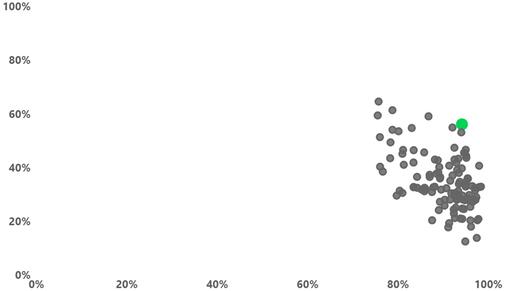
Economically
Special Education Student Population: 22%
Emergent Bilingual Student Population: 69%
Type of School: Traditional Public
Percentage of Students Meeting Grade Level in Math, Spring 2025, by Campus in Fort Worth
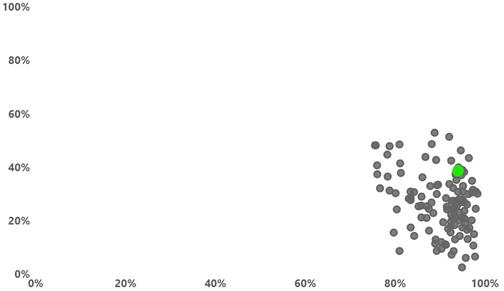

At César Chávez Primary, Principal Monica Ordaz leads with deep dedication to student success and an extraordinary sense of responsibility for advancing that vision Under her steady leadership, now in her thirteenth year at the helm of the campus, the school is a place where students and teachers feel supported, valued, and committed to shared accountability for outcomes Guided by their ‘COLT Pride’ values, including ‘O - Own It’ and ‘T - Take Responsibility,’ the campus has built a culture of ownership that extends across classrooms and grade-level teams Every adult takes responsibility for advancing student learning, reflects deeply on their instructional goals, works to align them across the campus, and is supported as a valued member of a close-knit team. As Principal Ordaz says, “The stakes, for our kids, are too high not to.” The result is a school that serves a high population of economically disadvantaged and dual-language learners with some of the highest rates of students being on grade level across Fort Worth
Chávez lives out the belief that “culture comes first ” they wanted their school to feel like, then built system approach is present in systems all across the school, students in the morning from the hallway, to how the engage families around it The campus code of cond language and set of expectations, while consistent te sense of support Teachers and students are a part o accountability go hand in hand
At Chávez, detailed vertical alignment planning is cen prepared for rigorous content Teachers work backwa grades, ensuring that every grade level is advancing goals each grade level is building towards On camp unpacked and shared across the campus to encourag blocks of strong writing in earlier grades Instructiona walkthroughs and professional learning communities basis, ensuring that the vision for student outcomes i
Chávez makes teacher development and growth a ce regularly observe one another, and excellent practice entire team PLCs are spaces for tackling shared chal and aligning instruction to meet student needs Cele morale and fosters a shared sense of ownership over
Principal Ordaz takes a deep approach to supporting Learning Objectives (SLOs) SLOs are a part of every required by the state, but Chavez treats the developm exercise Teachers set their SLO after a collaborative weeks, with campus leaders monitoring progress thro throughout frequent classroom observations The Ch process to create meaningful opportunities for teach practice Through this process, SLOs have become a building and sharpening focus on what students need oriented way.

César Chávez Primary’s success is the product of strong culture, clear instructional goals and alignment, and intentional teacher development, all guided by a leader who listens and learns alongside her staff and holds herself and all of the adults in the building to a commitment to continue raising the bar for student achievement Chávez demonstrates what is possible when systems are designed to balance both humanity and high expectations for student learning

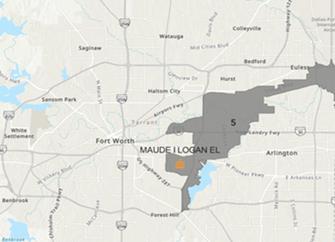
City Council District: 5
District: Leadership Academy Network
Principal: Michael Conner
Grades Served: Pre-K–5th
Enrollment: 319
The Leadership Academy at Maude I. Logan saw more growth in the percentage of students reading on grade level between 2019 and 2025 than any other school in Fort Worth (+33%) and is in the top 5 schools for growth in the percentage of students doing math on grade level during the same period (+14%) Such incredible growth, moving the campus to 53% of students reading on grade level and 31% in math on grade level, has turned the campus from one of the lowest performing schools in Fort Worth serving high economically disadvantaged student populations to one of the highest This has been accomplished under the direction of the Texas Wesleyan University Leadership Academy Network
Percentage of Students Meeting Grade Level in Reading, Spring 2025, by Campus in Fort Worth
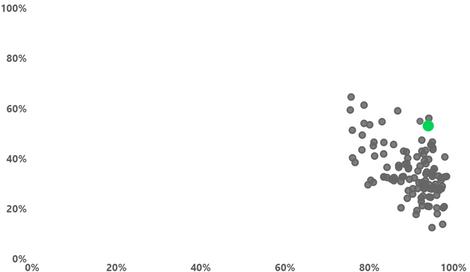
Economically Disadvantaged Student Population: 94%
Special Education Student Population: 19%
Emergent Bilingual Student Population: 41%
Type of School: District-Authorized Public Charter School
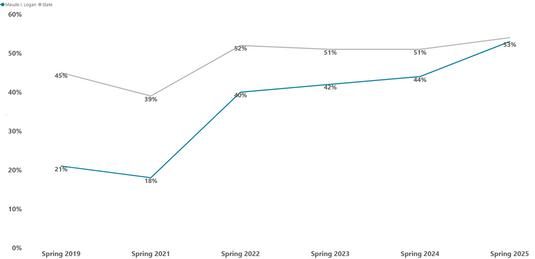
In the past six years, the Leadership Academy Network at Maude I Logan has completely closed the gap between the campus and the State of Texas in the percentage of students meeting grade level in Reading, with the campus having a significantly higher subpopulation of students experiencing poverty than the State as a whole

At the Leadership Academy Network at Maude I. Logan, Principal Michael Conner shared that both he and the campus have learned to do things differently. When the campus started with the Leadership Academy Network, students experienced significant academic achievement gaps, lagging both the district and the state in student academic performance. Fast-forward six years, the time it takes for a student to progress from pre-k to fifth grade, and the campus has completely closed the gap with the state in reading. Along the way, both school leadership and teachers have had to learn how to adapt to supporting their students in continuing their academic growth beyond just the initial progress
At Maude I Logan, “data-driven instruction” is more than just a buzzword; it’s the engine of instructional decision-making the campus uses to guide every instructional decision Teachers and leaders analyze student performance at the individual level, using six-week data cycles to assess progress, reteach key skills, and celebrate growth PLCs serve as spaces for deep collaboration, where teachers plan targeted lessons and monitor how students are moving toward mastery. This rhythm of assess–reteach–grow has built a campus-wide mindset that every student’s progress matters and every data point tells a story
As part of the Leadership Academy Network (LAN), Maude I Logan benefits from robust central academic and operational supports As Principal Conner shared, central support allows him and his leadership team to stay focused on instruction LAN’s Instructional Planning Calendars and assessment blueprints create consistency and provide a clear system expectation to ensure lessons are aligned across classrooms and grade levels. Regular coaching sharpens both campus leaders’ instructional lens, allowing them to guide their campus, and classroom coaching allows for rapid teacher development This layered support structure has created coherence across the campus; teachers know precisely what students should be learning in a given period, how they will be assessed, and how their lessons fit into the broader plan for student success
Maude I. Logan’s master schedule reflects a belief that every student deserves time to get what they need to grow, and building a schedule around the needs for intervention and enrichment is key to ensuring each student gets those critical supports Each day, students have a built-in intervention and enrichment block in math, as well as an additional weekly intervention block in reading These built-in blocks ensure that students are receiving personalized support and opportunities for acceleration Teachers plan for these blocks using the same data that drives core instruction, selecting materials and tasks that meet each learner where they are The result is a school day designed for differentiation, where time itself becomes a powerful lever for student achievement.
The belief that “ every kid can grow ” animates every part of Maude I Logan’s work Teachers and leaders operate from shared values, like “Kids First,” “Better Together,” and “Everybody Grows,” that define how they approach challenges and celebrate success Principal Conner models reflective leadership, evolving from a turnaround mindset to one focused on sustaining excellence Teachers feel supported and accountable, and students see that belief mirrored back at them each day This collective commitment to growth has transformed Maude I. Logan into a community where consistency, collaboration, and care drive lasting success

At The Leadership Academy at Maude I Logan, clear systems, such as those for intervention and the integration of data-driven instruction, along with a mindset that everyone grows, keep the campus focused on what needs to happen for students so that the school can sustain excellence, not just strive for it. Those systems, paired with strong central support for instructional planning, academics, and assessment, have been instrumental in supporting students to thrive and ensuring that “everybody grows. ”


As you read yourself thinking the same thing we did at first The practices highlighted in this report, echoed in our campus visits and conversations with school leaders and teachers, are not unfamiliar School culture, a belief in all students' ability to achieve at high levels, instructional coaching, teacher development, and data-driven instruction are school components we have all heard about before
Those ingredients are important and necessary What we have discovered, however, is that bright spot schools do not thrive simply because they have the right ingredients
Ingredients alone do not create a bright spot. The difference lies in the intentional way these schools bring those pieces together through thoughtful leadership, a culture that balances high expectations with high support, and intentional systems that support excellence every day
Bright spot schools build environments where great teaching is not left to chance, but developed through access to excellence resources, coaching, and a clear purpose. These schools create cultures where teachers feel both cared for and held accountable, where data is not just collected but understood and acted upon, and where every adult in the building believes that every student can and will achieve at high levels
It is not just about WHAT a school has in place but HOW those elements are implemented, used, refined, monitored, and sustained over time Bright spot schools turn strategy into practice and practice into results through leadership, consistency, commitment, and a shared vision of success
We hope you, like us, find this realization both humbling and deeply hopeful Because it means that solutions to our city’s most persistent educational challenges are not out of reach but already here in schools that are quietly proving what is possible every single day
If we learn from them, support them, and share their lessons widely, we can begin to make excellence the rule rather than the exception in Fort Worth.
Thechallengeswefacearereal,buttheyarenotinsurmountable.Our brightspotschoolsremindusofwhatispossible.Wecanlearnfrom thesesuccessesandscalethem,together,foreverychildinour community.


